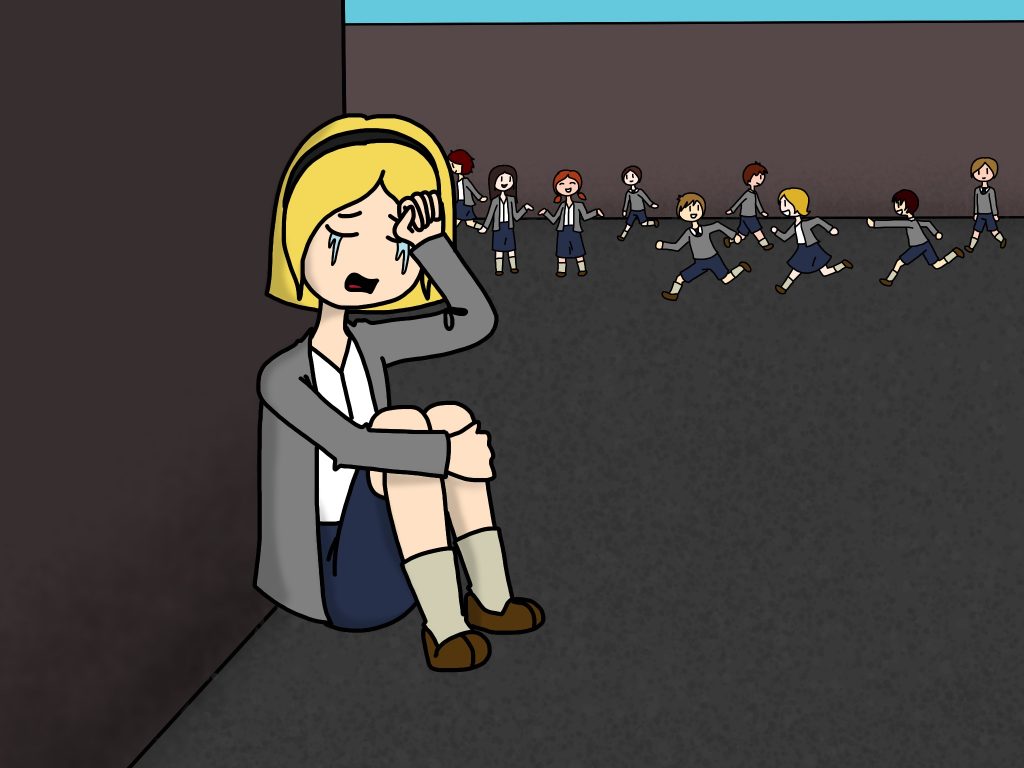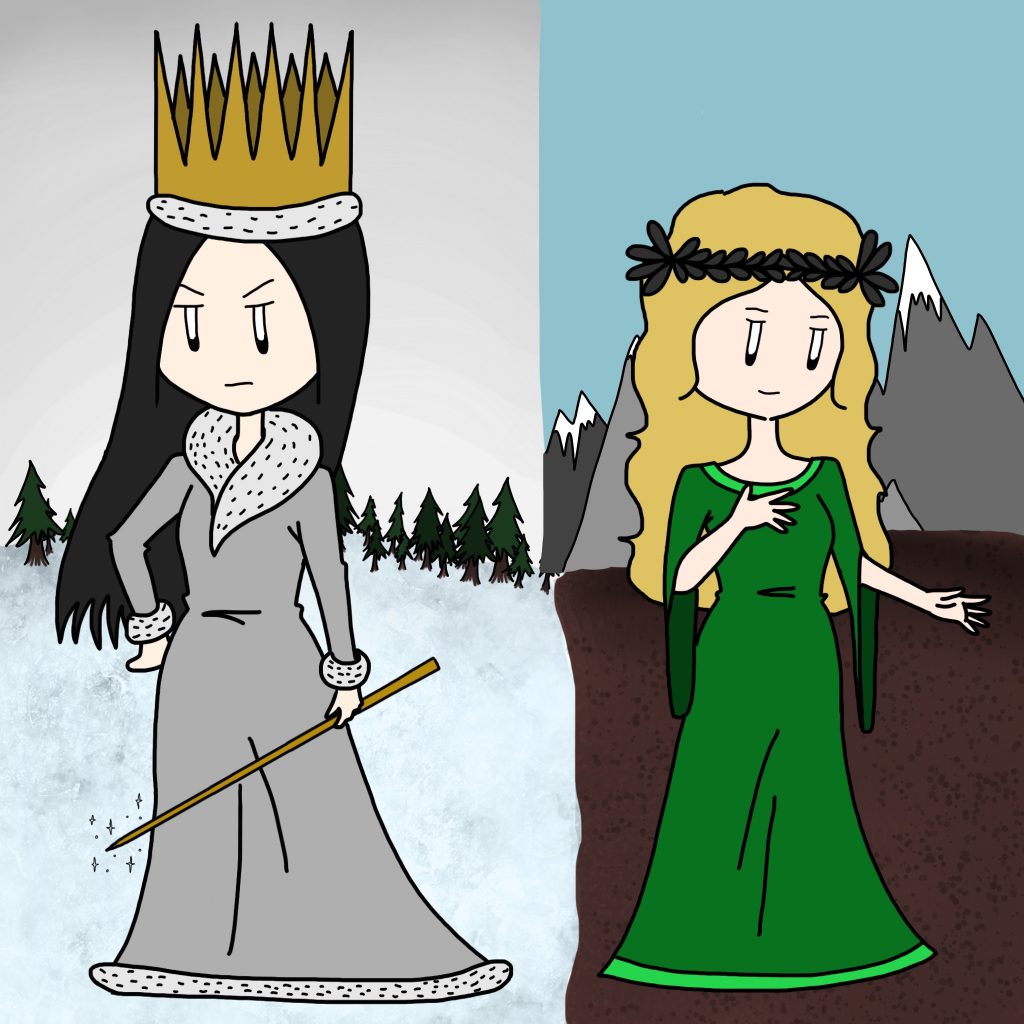The Chronicles of Narnia contain a countless number of social injustices and one of them is sexism. The Silver Chair, in particular, illustrates that female characters are weak, timid, and in need of guidance from a male character unless they are an evil antagonist. The Lady of the Green Kirtle is in a position of power, attractive, and self driven; however, she is also the story’s antagonist who ultimately needs to be defeated. The discrimination toward female characters is not only apparent in The Silver Chair but is a consistent problem throughout the entire series. The only characters throughout the series that are emphasized to be beautiful are the two evil witches, the White Witch and the Lady of the Green Kirtle, and Susan (who later is banned from Narnia because of her love for “feminine” products such as lipstick). The Silver Chair’s characterization of Jill, who is the only female protagonist, illustrates the stereotypical idea that females are not as capable or adventurous as males. Moreover, the story portrays Jill to be the “weakest link” who is in constant need of saving or guidance from a male. Although The Chronicles of Narnia holds many social injustices that could have negative impacts on certain readers, the focus of this project is on the inherent discrimination of female characters in The Silver Chair and where C.S. Lewis could have drawn his inspiration from. This will include an examination of biblical references, history, and a look at the other books in The Chronicles of Narnia.
Photograph by Vittorio Staffolani, https://www.pexels.com/photo/scenic-view-of-snowy-mountain-763771/ , License: https://www.pexels.com/license/
Before examining the particulars of C. S. Lewis’s treatment of women it is important to briefly review the plot of The Silver Chair.
Now that we know the basics of the plot let’s take a closer look at The Lady of the Green Kirtle and her characterization.
Since C. S. Lewis was Christian it is important to examine possible connections between The Lady of the Green Kirtle and other powerful (albeit infamous) women in the bible.
A unique feature of The Lady of the Green Kirtle is her ability to change her form. But she does not just change into any form, she changes into a serpent, which happens to have many significant biblical connections as explained below.
The most well-known connection between serpents and the bible is the creation story presented in Genesis. It is the serpent that tricked Eve into eating the apple and as punishment God forced it to crawl on its belly for all time. Because of this, the image of the serpent is often related to that of evil, wickedness, and even Satan. In Revelation 12:9 it even states that “The great dragon was hurled down—that ancient serpent called the devil, or Satan, who leads the whole world astray.” Since it was Eve who was tricked there is also a connection between women and serpents which insinuates that both are in some way connected to evil or evil intentions. While the story of the Eve and the serpent is not inherently misogynistic “its cultural receptions and interpretations by later Biblical scholars and church authorities, down through the ages, strengthen the cultural construction of Eve as the temptress, the destroyer of man and the ally of Satan, the serpent.” (Chakraborty 157). However, this is not to say that the biblical image of the serpent was entirely negative. In Hebrew scripture “…snakes may embody either positive or negative qualities.” (Knowles 166), an example of some of the positive qualities associated with snakes was wisdom and shrewdness. In Matthew 10:16, Jesus states to his followers, “I am sending you out like sheep among wolves. Therefore, be as shrewd as snakes and as innocent as doves.” But while the image of serpents/snakes in biblical texts were somewhat mixed it seems Lewis decided to firmly portray them as something evil within The Silver Chair.
Artwork by GDJ, https://pixabay.com/vectors/snake-serpent-line-art-reptile-5689373/, License: https://pixabay.com/service/terms/#license
Now that we have established some biblical connections, let’s examine what was going on in the world around the time C. S. Lewis wrote the story.

During the time that C.S. Lewis wrote The Silver Chair, women’s roles were changing significantly, and therefore, his perceptions on women and their roles could have been heavily influenced by their developing autonomy. In Caitriona Beaumont’s essay, she claims that how society viewed women in Britain, in the 1950’s, was in flux. Beaumont argues that there are many theories about women and what they actually wanted during this time period and one is the idea that women “aspired only to marriage and motherhood,” but Beaumont illustrates that their lives were more complicated (Beaumont 148). It was believed by many that when women got married they would “willingly dedicate themselves to family life”; however many women did not only want to be housewives, and in fact, many women wished to work outside the home and were seeking further gender equality (Beaumont 148). Women were becoming more than just being viewed as someone’s wife or mother. Women were “also workers, consumers, and citizens” (Beaumont 151). Women’s transforming roles are important in trying to understand why C.S. Lewis characterized women the way that he did. Because women were gaining courage and speaking up for what they wanted, society, and especially men, could have started to feel threatened by their independence. How society viewed women could have had a strong impact on C.S. Lewis’s perspective of women, and therefore, this could have influenced how he decided to portray his female characters. Women during the 1950’s were discovering the power of their own voices and they were learning how to use them. Moreover, the female characters in his novels that are independent, powerful, and determined are also enemies such as The Lady of the Green Kirtle. This could be illustrating C.S. Lewis’s, and society’s, intimidation regarding women in powerful positions. In fact, The Silver Chair focuses attention on Jill not liking Prince Rilian at first because of his dependence on The Lady of the Green Kirtle. Even though he does have ambitious female protagonists, they are always children and always have the help of a boy such as Jill and Eustace.
Artwork by ArtsyBee, https://pixabay.com/illustrations/retro-housewife-vintage-collage-1254131/, License: https://pixabay.com/service/terms/#license
Artwork by Unknown, https://www.wallpaperflare.com/gray-knight-armor-artwork-women-weapon-adult-people-fantasy-wallpaper-tuxc , License: https://www.wallpaperflare.com/terms-of-use
The Silver Chair not only illustrates women as being incompetent without male assistance but also that they have to distance themselves from their beauty to fight. Even though The Chronicles of Narnia “contain many strong and centrally important female characters,” they are either children or evil witches (Fredrick and McBride 37). Both The Lady of the Green Kirtle and the Witch Witch are “bad females,” and both their purposes are to “serve primarily as temptations to men” and to be evil antagonists to defeat (Fredrick and McBride 36). The Lady of the Green Kirtle even has to physically change her form from being a beautiful witch into a serpent in order to fight against Puddleglum, the children, and Prince Rilian. Before changing her physical appearance, she is only able to use her words, music, and green powder as sources of enchantment and manipulation. It is also worth noting that every one of the female children are accompanied by a male child, and these males are emphasized to be the leaders and in the ultimate position of power. For example, even though Lucy discovered Narnia first and wanted to save it, Peter was given the position of being the high king. Digory is illustrated to have power over Polly because he is older and therefore stronger. Lastly, even though Jill is given the signs from Aslan, she is shown to be timid and needing to be constantly encouraged by Puddleglum and Eustace.
Although The Chronicles of Narnia presents many other harmful themes including racism, how C.S. Lewis portrays his female characters is especially problematic as the series is labelled as being children’s literature. In Rawia Hayik’s essay she suggests that children’s literature is perhaps one of the most influential aspects throughout children’s childhoods, and therefore, she raises her concern about the harmful effects that gender roles have on their developing identities. In Hayik’s essay, her purpose is to draw attention to the stereotypical gender roles in children’s literature. By doing a critical thinking exercise, she challenged middle school students to think about female characters such as Cinderella. The children responded with answers suggesting that Cinderella is beautiful yet dependent on a man to rescue her. Hayik then asked the students to think about what this suggests about how females are portrayed in children’s fiction, and children responded with statements including “they need care,” “they must be pretty,” “they are usually weak,” and that they are in need of a man (Hayik 412). Even though Hayik knows that there are a few exceptions, she states that “females are mostly portrayed as either meek, submissive, and attractive characters or evil and jealous creatures” (Hayik 409). In The Chronicles of Narnia C.S. Lewis focuses a lot of attention on his antagonists’ beauty, such as The Lady of the Green Kirtle. Even though his portrayal of antagonists being independent, powerful, and beautiful does not follow the typical description of evil characters, they are concerning. Throughout this series, C.S. Lewis emphasizes the evil, feminine, and ambitious characters’ beauty; however, they are always killed or in Susan’s case, banned from Narnia and Aslan’s Country. Hayik’s essay illustrates that children are able to recognize the negative portrayals of female characters, and the Chronicles of Narnia illustrates that unless you are a child, being pretty, powerful, and a leader is a negative quality. Because Hayik’s study was successful in illustrating that students can be harmfully impacted by the stereotypical ways that females are represented, C.S. Lewis’s portrayal of beautiful women could be damaging to children’s development.
Photograph by Unknown, Free Images : tree, nature, forest, grass, book, read, person, people, girl, sunlight, leaf, flower, spring, sitting, autumn, child, human, season, long hair, blond, out, woodland, habitat, have a look 6000×4000 – – 736131 – Free stock photos – PxHere, License: https://pxhere.com/en/license

C.S. Lewis initially portrays Jill to be a rather whiny, timid, and cranky child. At the beginning of the novel, bullying is illustrated to be a common activity among the children at Jill’s “mixed” school and she seems to be a target. For example, she is first introduced in the novel to be crying from something that the bullies said or did to her. Throughout the novel, she often complains such as when she states how “beastly [she] feels after sleeping” in her clothes and without being able to wash (Lewis 66). Jill is also illustrated to be deeply afraid of the thought of giants and the dark. Her fear of the dark is stressed when they all have to crawl through a small dark tunnel in the Underworld. Despite her being illustrated to be whiny, she is also shown to be a child with an open mind such as the other child female protagonists Lucy and Polly. She is someone who is willing to believe without seeing. When Eustace tells her about his past adventure in Narnia, even he turns red in the face with how silly it sounds; however, Jill chooses to believe him. Even though at the beginning of their adventure in Narnia she complains quite often, remembering her age is important. She is only a child, and she is in a strange environment with a major responsibility, and she is cold and hungry, so no wonder she is cranky. When they find out that the giants want to eat them, Jill is the one that tricks them into believing that they love it there and they wish to explore the outside of the castle. Because Jill convinces them to let them go outside, they are able to escape. When they are trying to find a way out of the Underworld, Jill is the one who crawls up the dark hole to see where the shining “cold blue sort of light” leads to (Lewis 225).

When Jill first meets Prince Rilian, she does not like him that much because of his plan to rule Narnia (a plan that the The Lady of the Green Kirtle has manipulated him to believe is right). However, she also does not like the fact that he plans on following her “rules.” For instance, she states “[w]here I come from…they don’t think much of men who are bossed about by their wives” (Lewis 166). The portrayal of evil women needing to be defeated throughout The Chronicles of Narnia emphasizes the belief that the “disempowerment of women empowers men” (Hayik 413). For example, once the white witch and the Lady of the Green Kirtle are killed, the men resume the power of the throne. Women in powerful positions during the time that these novels were written were unfamiliar and new to society. Therefore, this scene with Jill and Rilian draws attention to the fact that women at this time were seen as intimidating for having authoritative roles or gaining their independence.
Photograph by Kobitriki, https://pixabay.com/users/kobitriki-27036/, License:https://pixabay.com/service/terms/#license
Like other female child characters in this series such as Polly and Lucy, Jill becomes determined to help, and her character continues to develop into the last novel of the series The Last Battle. Jill’s character development, which is emphasized in The Last Battle, could be showing that over time C.S. Lewis was “more willing to blend gender traditions” (Fredrick and McBride 31). Lucy, Polly, and Jill are the only female characters throughout the series that are independent and ambitious without being portrayed as evil antagonists. However, they are all children. Polly was the first female child to discover Narnia, and she willingly helps Digory find the apple needed to grow the tree of protection, in The Magician’s Nephew. Polly is brave, and she finds excitement in exploring mysterious rooms throughout her home. Lucy is the second child to discover Narnia, and her independence is highlighted when she continues to believe in Narnia, despite her siblings trying to convince her that it is only her imagination. She is also determined to help save Narnia from the White Witch and rescue Mr. Tumnus. Jill is the only female child out of the three that is portrayed to be whiny; however, her character does undergo transformation, as in The Last Battle, she is illustrated to be “brave and eager” and is willing “to fight and die for Narnia” (Fredrick and McBride 31). Susan is the only other female human protagonist in this series; however, C.S. Lewis gave her character a much different path than the rest. When Susan becomes a teenager, just like Peter, Lucy, and Edmund, she is no longer welcome in Narnia. However, unlike all the other human protagonists, she is not welcome in Aslan’s country because of her love for lipstick, nylons, and invitations. In The Last Battle, she is portrayed to be simply too grown up to be welcome, and to believe, in Narnia, and this is shown when all of the protagonists die and arrive together in “Heaven” without Susan.
Artwork by Aom Woraluck, Vintage Owl Images | Free Photos, PNG Stickers, Wallpapers & Backgrounds – rawpixel, License: https://www.rawpixel.com/services/licenses

The White Witch, also referred to as Jadis, first appears in The Lion, the Witch and The Wardrobe based on the order of publication. She is the novel’s evil antagonist whose desire is to take over and rule Narina. She is responsible for putting an enchantment over Narnia, making it stuck in the cold season of winter–always winter never Christmas.

The White Witch was present in the creation of Narnia and is explained in the book, The Magician’s Nephew. She originated in the world called “Charn,” which she overpowers and destroys, leaving only herself alive. She then puts an enchantment over herself so that she is preserved until someone wakes her. Unfortunately, she is woken unintentionally by curious Digory. After accidentally bringing her back to “our” world by the two children, Digory and Polly, they attempt to return her to Charn but end up in Narnia. Jadis, and the others including Digory and Polly, witness the creation of Narnia; however, she can feel the “good” magic in Aslan’s song and takes off. Aslan knows that she has bad intentions, and therefore, he plants a tree in order to keep Narnia safe from her. Although she is portrayed to be wicked, C.S. Lewis emphasizes her beauty. Along with others, both Uncle Andrew and Digory are drawn to her beauty. She is also described in both The Magicians Nephew and The Lion, the Witch and The Wardrobe to be much taller than a “regular” human being. But despite her beauty and human-like appearance Jadis ends up being regarded as one of the strongest and most evil villains in the land of Narnia.
Photograph by Unknown, https://pixabay.com/photos/winter-snow-snowfall-wintry-cold-2576614/, License: https://pixabay.com/service/terms/#license
Just like The Lady of the Green Kirtle does to her victims, Jadis uses “temptation” on Digory, as he tries to successfully complete his mission for Aslan. After Jadis throws “away the core of an apple which she had eaten,” the text draws attention not only to how much stronger she looked but also to her face and how it turned “deadly white, white as salt” (Lewis 190, 191). She then tries to manipulate Digory into defying Aslan by telling him that he should take the apple and use his magical ring to go back home to his mom, instead of taking the apple back to Aslan as he is supposed to. This act of manipulation is similar to when The Lady of the Green Kirtle tempts Jill, Eustace, and Puddleglum into entering the castle of the “gentle” giants. Even though the gentle giants did welcome the children and Puddleglum with food and warm baths as the Witch said, they had evil intentions to eat the children and Puddleglum, which would have prevented the children from saving Rilian. Similarly, Digory taking the apple home would have put a stop to Aslan’s plan to grow the tree that would keep the White Witch out of Narnia for a while. In both of these manipulative interactions with the children (and others), neither of the two witches act violently but rather use spoken words to try and trick their enemies.
Artwork by Unknown, https://www.hippopx.com/en/lion-snow-lying-down-art-animal-nature-scrapbooking-960, License: https://www.hippopx.com/en/terms-of-use

Even though in The Lion, the Witch and the Wardrobe the White Witch has a magical wand that can turn anything to stone or dust, she continues to use temptation as a source of power. She has a cordial that looks “as if it were made of copper” and can create food and drinks out of thin air; however, the food and drinks enforce an enchantment. This is illustrated during Edmunds first experience in Narnia. He becomes so tempted by the thought of having more and endless amounts of Turkish delight that he becomes loyal to The White Witch. The enchantment causes him to risk his own life and well as the lives of his siblings.
Photograph by Elsa Bear, https://www.pinterest.ca/pin/694539573771555962/, License: https://help.pinterest.com/en/article/copyright

C.S. Lewis’s portrayal of beautiful witches is fascinating considering witches are typically known in children’s literature to be ugly or not as beautiful as someone else such as the story’s protagonist. For example, Snow White and the Evil Queen, The Wicked Witch of the West, Ursula, Cruella, etc., are all portrayed to be “ugly” in some way or craving beauty. Lewis, instead, seems to weaponize beauty by making it something that is both desirable yet ultimately dangerous.
Artwork by Unknown, https://pixabay.com/vectors/witch-evil-scary-spooky-halloween-1751025/, License: https://pixabay.com/service/terms/#license
The Silver Chair cannot only be harmful to how children perceive women but it can also cause identity confusion. Even though The Silver Chair has potential to be incredibly detrimental to children’s developing minds, it can also be a learning opportunity if read with care. The Chronicles of Narnia presents many other social injustices not only concerning its female characters but also race and people of colour. C.S. Lewis’s representation of powerful and beautiful women could guide children into believing that unless you are a child, females cannot be beautiful and in a place of power without being considered evil. Jill makes this clear when she mentions that women should not be placed in a position above men. Children are smart, and they are able to recognize and absorb these damaging social injustices, and therefore, the series should not be promoted to children unless read with an adult who will encourage conversations surrounding the problems. These conversations should not only arise if the children notice them, but instead, the adult who is doing or guiding the reading should point them out, and they should explain not only that they are wrong but also why. The Chronicles of Narnia can be used as education tools to teach children of all the wrongdoings that have happened and are still happening in the world. Children need to be aware and have an understanding to offer their support and help make the world a better place. Every person is powerful, brave, and courageous. These features are not limited to only one gender, age group, or race as C.S. Lewis has presented.
Work Cited
Beaumont, Caitrìona. “What Do Women Want? Housewives’ Associations, Activism and Changing Representations of Women in the 1950s.” Women’s History Review, vol. 26, no. 1, Jan. 2017, pp. 147-162. Taylor & Francis Online, doi:10.1080/09612025.2015.1123029.
Chakraborty, Suman. “Women, Serpent and Devil: Female Devilry in Hindu and Biblical Myth and its Cultural Representation: A Comparative Study.” Journal of International Women’s Studies, vol. 18, no. 2, Jan. 2017, pp.156-65. ProQuest Central, www.proquest.com/scholarly-journals/women-serpent-devil-female-devilry-hindu-biblical/docview/1869850340/se-2.
Fredrick, Candace, and Sam McBride. “Battling the Woman Warrior: Females and Combat in Tolkien and Lewis.” The Mythopoeic Society, vol. 25, no. 97/98, April 2007, pp.29-42. ProQuest Central, go.exlibris.link/L90tqbV3.
Hayik, Rawia. “What Does This Story Say About Females? Challenging Gender-Biased Texts in the English-Language Classroom.” Journal of Adolescent & Adult Literacy, vol. 59, no. 4, Jan. 2016, pp. 409-419. JSTOR, doi:10.1002/jaal.468.
Knowles, Michael P. “Serpents, Scribes, and Pharisees.” Journal of Biblical Literature, vol. 133 no. 1, 2014, pp. 165-178. Project MUSE, doi:10.1353/jbl.2014.0008.
The Bible. New Revised Standard Version, Bible Gateway, 1989.